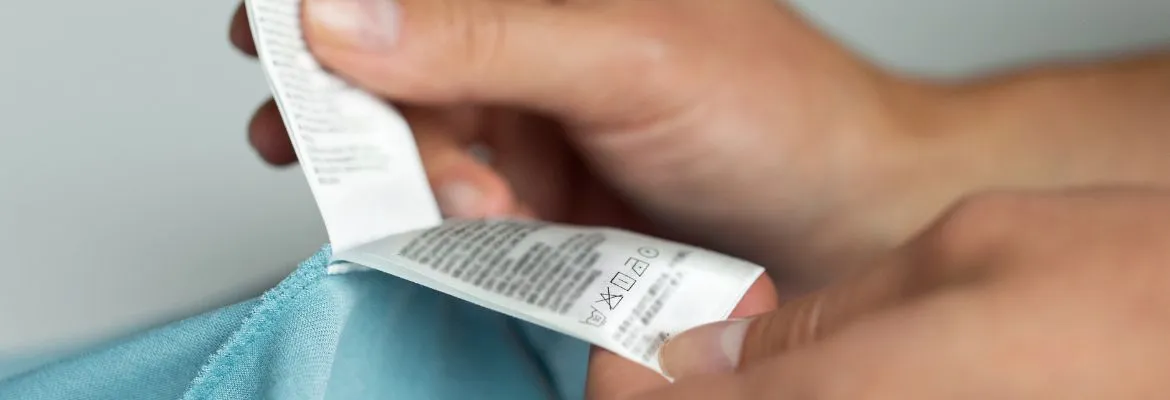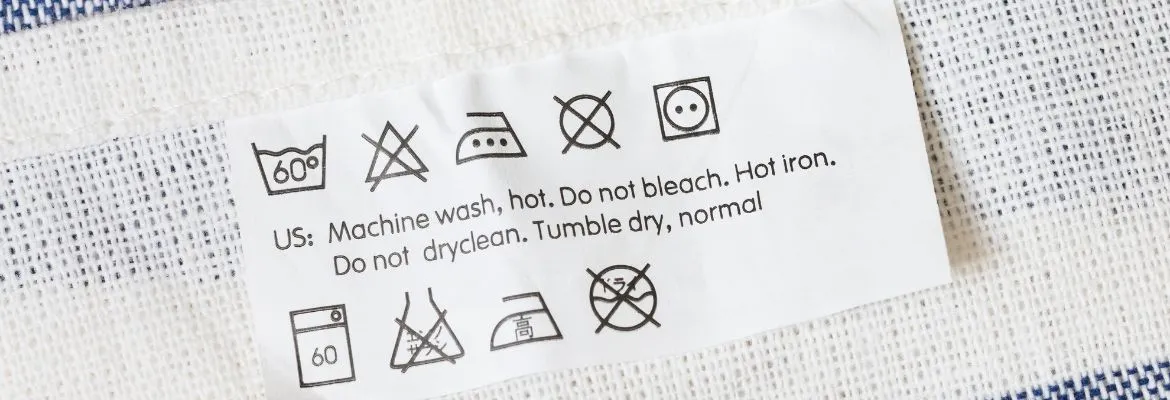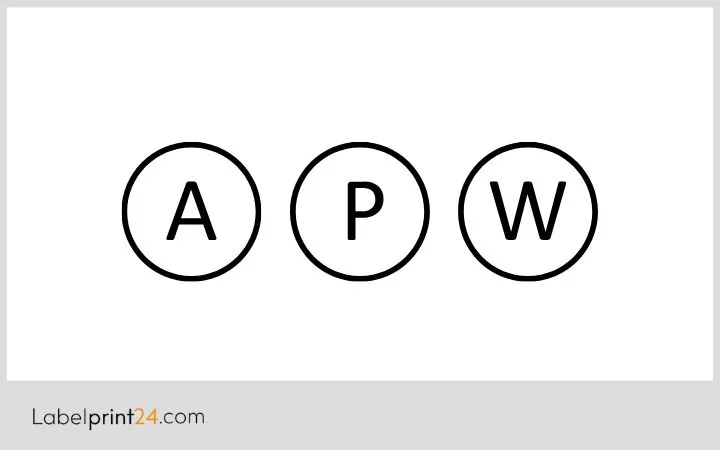
Textile labels - What the symbols mean
Textile companies are obliged to indicate the respective material of their clothing. Care instructions are also enormously important for the end consumer who wants to wear the clothing. Therefore, textile labels are attached to clothing or other fabric products to convey important information about care and the material. Textile labels are not only suitable for clothing, but also for other fabric products such as gym bags, fabric bags, fabric napkins, towels, carpets and much more. In the following sections, we would therefore like to introduce you to textile labels in more detail and how to properly clean as well as care for clothing.

Definition: Textile labels and their symbols
You are certainly familiar with textile labels, which are attached directly to your clothing. Basically, many products have labels that contain various information. The price, the ingredients, facts about the company or other important information can play a role.
Similarities and differences with other types of labels:
Textiles also have labels that indicate the price or provide information on the raw materials as well as the origin. In addition, there are labels that contain more detailed statements on the handling of the respective garment.
However, unlike price stickers, for example, these labels are firmly attached to the respective product, or more precisely sewn. In addition, they are not clearly visible on the outside, but often more hidden on the inside of the respective garment.
When looking at the material, the labels for textiles (at least those that contain information on treatment) also differ from other labels. Not only are they made of paper or foil, but they can also be made of satin, for example, which is made of polyester. In the best case, recycled material is used. In this way, an added value for sustainability can be achieved.

Product Advisor for Labels
Whether it’s a simple roll label or a multi-layered specialty label – I’m your go-to person for questions concerning materials, adhesion, and finishing of labels for the pharmaceutical, cosmetic, food, chemical, and almost any other industry.
"Paper or film? We've got the perfect label!"
I will be happy to help you personally.
Information on the labels:
The information on the labels is mainly about the care of the garments. The labels are intended to prevent the textiles from being destroyed by incorrect handling or from deteriorating visually over a longer period of time.
After all, certain fabrics are very sensitive and could change their shape in such a way that you end up no longer being able to use or wear the garment. The symbols mainly refer to the areas:
- Washing
- Drying
- Ironing
- Bleaching
- professional cleaning of textiles
There are additional subcategories in the respective areas. Washing symbols, for example, may refer to the temperature, but also to the spin cycles that can be easily applied to the garment.

Labels for textiles: symbols for washing
There is a whole range of symbols for washing. The base offers a symbol with three lines each (a horizontal one with two side lines pointing slightly upwards - a kind of tub). At the top you see a wavy line that is supposed to symbolise water.
Info on the washing temperature:
First of all, the temperature is indicated, and in a very simple way. Inside the symbol you will find the degree number in Celsius. This normally has one of the following values:
- 30 degrees
- 40 degrees
- 50 degrees
- 60 degrees
- 70 degrees
- 95 degrees
The numbers always indicate the maximum temperature; you can also wash the garment at a lower value or at a lower temperature. Alternatively, the possible temperature in this symbol can be represented by dots.
For one point, the maximum temperature is 30 degrees, for two points 60 degrees and for 3 points 95 degrees. However, this type of labelling is used less frequently - if you take a quick look in your garments, the probability that you will find the corresponding points is rather low.
Info on the wash programme that can be used:
Further variants of the described wash symbol show you which programme your laundry is possible with. More precisely, these indications refer to the respective options for spinning.
The described wash symbol without any further information or signs means that maximum spin in the dryer is possible. If you find another horizontal line on the bottom, you must spin the garment gently.
Two lines under the symbol on the label of the garment indicate that spinning is completely prohibited. There is also a special symbol that indicates that you should not wash the garment in the washing machine, but by hand. Fittingly, the symbol is represented by a black hand going through the "water line" of the tub.
.jpg)
Symbols around drying
On the labels of the textiles, you will also find symbols that provide you with precise information on how to dry a garment.
Purpose of the symbols and basic structure:
The basis for these symbols is a circle placed inside a square. This applies at least if the laundry is to be dried in a dryer and not in the air or without technical aids.
You are certainly aware that certain textiles can shrink when drying, i.e. they become smaller. If this happens, they are no longer usable - an extremely annoying situation.
Statements of the details in the symbol:
If a dot is shown in the circle, you should make sure that you put the respective textile in the dryer with a gentle programme. The most important thing here is a low temperature.
%2520(9).jpg)
Two dots, on the other hand, say that you can let the garment dry normally - so you don't have to pay attention to special aspects like the sensitivity of the fabric. If you see a third dot in the circle already described, the textile can even be dried hot.
A final dryer symbol that you should know and pay attention to in any case is the circle in the square crossed out with a cross. In this case, drying the garment in the dryer is completely prohibited. You can assume that if you ignore the sign, the laundry will most likely suffer damage.
Ironing and bleaching
Other options for treating a garment that are marked on textile labels relate to ironing and bleaching. The basis for information on the former is provided by the iron symbol, which is easily recognisable by its shape.
Symbols with information on ironing:
If the iron is crossed out, the garment is not suitable for this type of treatment and you should keep it that way. Otherwise, delicate fabrics in particular can be damaged.
Other ironing symbols indicate the temperature at which the garment can be ironed. The number of dots visible in the symbol is decisive here. In this context, there are three levels:
- one dot means ironing at low temperature
- two dots mean ironing at medium temperatur
- three dots mean ironing at high temperature
There are also concrete numbers in degrees Celsius for the corresponding levels. Low level means that you should iron at a maximum of 110 degrees. The medium setting is 150 degrees, and the highest 200 degrees.
To avoid making mistakes, it is important to familiarise yourself with the functions of a new iron before ironing for the first time.
.jpg)
Bleach clothes correctly according to symbols:
Bleaching is mainly significant to remove stubborn stains in clothes that cannot be removed by simple washing.
The bleaching information, in turn, is transported in a triangle. Here, too, there are some details that need to be observed so that your garments are not damaged.
A simple triangle without further symbols means that bleaching is possible without any problems. A crossed-out triangle, on the other hand, prohibits bleaching of the garment in question.
In the case of a stubborn stain, professional cleaning may be necessary. Two lines in the triangle indicate that the item may only be bleached with oxygen, while the abbreviation CL stands for the possibility of bleaching with chlorine.
Labels for professional cleaning
In addition to these symbols, there are other indicative signs that are intended for professional cleaning. These symbols indicate the potential way in which the garment can be cleaned. Professional cleaning is mainly used for garments that are made of high quality and sensitive fabrics.

These include velvet and satin, among others. The aim here is to prevent the pieces from deteriorating in their visual appearance through the special sensitivity of professional textile care.
The individual options are represented by a simple circle, often supplemented by letters. The latter indicate a precise form of care, including the use of certain chemical substances.
An empty circle indicates to professionals in the mangle that the garment should be gently cleaned. A large A in the circle indicates that the most common solvents can be used for cleaning.
A P, on the other hand, indicates that care with perchloroethylene is an option. The "F" indicates that the garment can easily withstand cleaning with hydrocarbon solvents. "W" indicates professional wet cleaning.
Conclusion
Textile labels have a special function. They provide you, the consumer, with information on how to care for the garment in question. The symbols on the labels refer to aspects such as washing temperature, drying, ironing and professional cleaning. By following the labels in the textiles, you can be sure that no damage will occur to your garment and that the quality and visual appearance will not deteriorate.
FAQ
What distinguishes textile labels from other types of labels?
The special feature of textile labels is that they are firmly attached to the respective garment and are usually found on the inside. They are also made of a different material that is used in label printing.
Why is it important to pay attention to textile labels?
Paying attention to textile labels is essential in order to benefit from a visually appealing and well-kept garment over a longer period of time.




